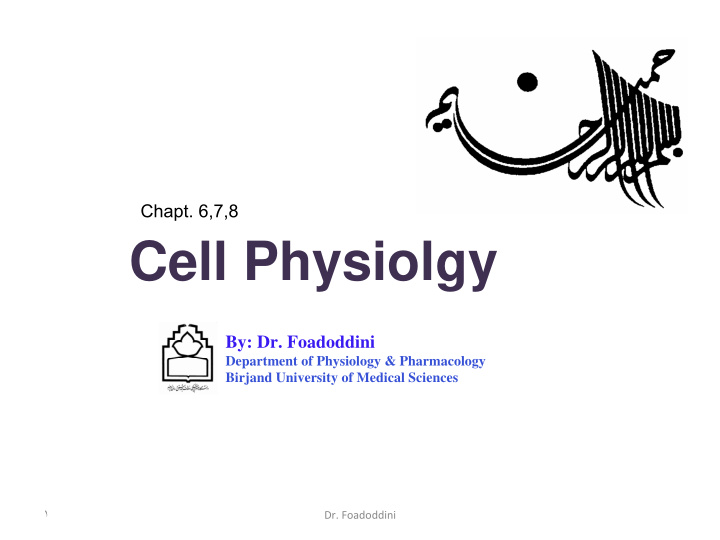



Chapt. 6,7,8 Cell Physiolgy By: Dr. Foadoddini Department of Physiology & Pharmacology Birjand University of Medical Sciences ١ Dr. Foadoddini
Contraction of Skeletal Muscle ٢ Dr. Foadoddini
٣ Dr. Foadoddini
٤ Dr. Foadoddini
T ‐ tubule ٥ Dr. Foadoddini
Sliding Filament Mechanism ٦ Dr. Foadoddini
٧ Dr. Foadoddini
٨ Dr. Foadoddini
٩ Dr. Foadoddini
١٠ Dr. Foadoddini
١١ Dr. Foadoddini
١٢ Dr. Foadoddini
active tension ١٣ Dr. Foadoddini
Tension N Length ١٤ Dr. Foadoddini
١٥ Dr. Foadoddini
Energy for: Sliding Ion Pumps Sources of Energy: 1. Phosphocreatine 2. glycolysis" of glycogen 3. Oxida tj ve metabolism Efficiency of Muscle Contraction: ٢۵ % Max at a moderate velocity ١٦ Dr. Foadoddini
muscle twitch: a single, sudden contraction lasting for a fraction of a second. Latency The characteristics of isotonic contraction depend on the load and the inertia of the load. However, the isometric system records strictly changes in force of muscle contraction itself. Therefore, the isometric system is most often used when comparing the functional characteristics of different muscle types. ١٧ Dr. Foadoddini
Fast Versus Slow Muscle Fibers M otor unit: All the muscle fibers innervated by a single nerve fiber . ١٨ Dr. Foadoddini
Force Summation: Multiple fiber summation : ( size principle) are driven asynchronously Thus providing smooth contraction Frequency summation: tetanization The Staircase Effect (Treppe) muscle tone Muscle Fatigue ١٩ Dr. Foadoddini
Coactivation of Antagonit Msuscles Remodeling of Muscle to Match Function Hypertrophy the number of actin and myosin filaments in each muscle fiber Atrophy Hyperplasia actual number of muscle fibers Adjustment of Muscle Length Effects of Muscle Denervation Atrophy, degenerative changes, replaced by fibrous and fatty tissue, contracture ٢٠ Dr. Foadoddini
Excitation of Skeletal Muscle: Neuromuscular Transmission and Excitation-Contraction Coupling ٢١ Dr. Foadoddini
٢٢ Dr. Foadoddini
٢٣ Dr. Foadoddini
End- plate potential ٢٤ Dr. Foadoddini
Ca K ٢٥ Dr. Foadoddini
Type of drugs: ٢٦ Dr. Foadoddini
Curar Botulinum ٢٧ Dr. Foadoddini
In Frog muscle Heart ٢٨ Dr. Foadoddini
Calsequestrin Dr. Foadoddini ٢٩
Excitation ‐ Contraction Coupling ٣٠ Dr. Foadoddini
Smooth Dr. Foadoddini Muscle ٣١
mass of hundreds to thousands of smooth muscle fibers that contract together as a single unit. adherent to one another many gap junctions Depolar. Without action potenential but junctional pot .. Syncytial smooth muscle Visceral smooth muscle Control mainly by nerve signals By non-nervous stimuli ciliary muscle , iris muscle of the eye, piloerector gut, bile ducts, ureters, uterus, muscles that cause erection of the hairs many blood vessels. ٣٢ Dr. Foadoddini
dense bodies A/M= 5 to 10/1 Vs, 2/1 in skletal "side polar" cross-bridges So, contract as much as 80 per cent of their length ٣٣ Dr. Foadoddini
Tonic contraction, sometimes lasting hours or even days Slow Cycling of the Myosin Cross-Bridges far less ATPase activity Less Energy Ryequired to Sustained Contraction Slowness Of Onset Contraction and Relaxation Force of Muscle Contraction "Latch“ Mechanism for Prolonge Holding of Contraction of Smooth Muscle Stress- relaxation as the activation of the enzymes decreases, the cycling frequency decreases, allows the myosin heads to remain attached ٣٤ Dr. Foadoddini
Cross-bridge activation in smooth muscle Ca 2+ -stimulated myosin phosphorylation 4 Ca 2+ myosin light Ca Cm 4 chain kinase (MLCK) Calmodulin, Cm myosin light Ca Cm 4 chain kinase Mg 2+ ATP ADP regulatory P light chain relaxation contraction myosin P phosphatase ٣٥ Dr. Foadoddini
٣٦ Dr. Foadoddini
٣٧ Dr. Foadoddini
Smooth muscle can maintain force with reduced energy expenditure Smooth muscle has the ability to maintain force development even when a high [Ca 2+ ] and hence cross-bridge turnover is not maintained. Maintained force development, but with reduced velocity of movement, confers a clear physiological advantage to smooth muscle and is absent from striated muscle. [Ca 2+ ] force velocity & crossbridge phosphorylation stimulation ٣٨ Dr. Foadoddini
contact junctions diffuse junctions Excitatory and Inhibitory Transmitter Substances Ach NE Type of receptor ٣٩ Dr. Foadoddini
slow wave rhythm pacemaker waves self-excitatory voltage-gated calcium channels Excitation of Visceral Smooth Muscle by Muscle Stretch Excitation or Inhibition Hormones and Local Tissue Factor ٤٠ Dr. Foadoddini
٤١ Dr. Foadoddini
Recommend
More recommend